托福OG TEST 2——green icebergs原文翻译。解析
- 格式:doc
- 大小:19.50 KB
- 文档页数:3
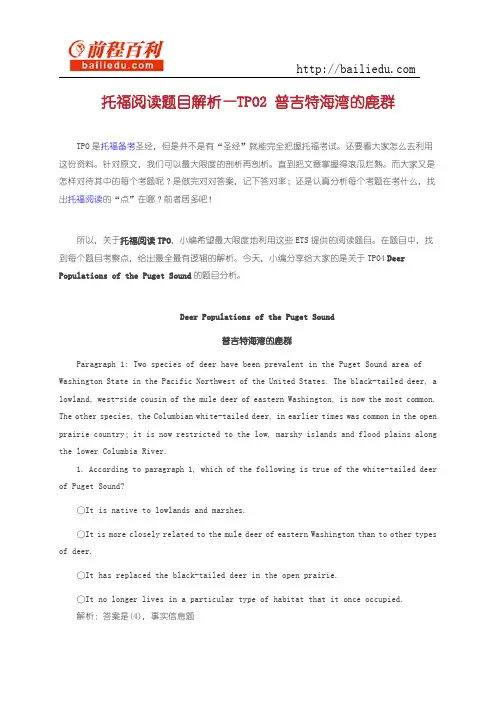
托福阅读题目解析—TPO2普吉特海湾的鹿群TPO是托福备考圣经,但是并不是有“圣经”就能完全把握托福考试。
还要看大家怎么去利用这份资料。
针对原文,我们可以最大限度的剖析再剖析。
直到把文章掌握得滚瓜烂熟。
而大家又是怎样对待其中的每个考题呢?是做完对对答案,记下答对率;还是认真分析每个考题在考什么,找出托福阅读的“点”在哪?前者居多吧!所以,关于托福阅读TPO,小编希望最大限度地利用这些ETS提供的阅读题目。
在题目中,找到每个题目考察点,给出最全最有逻辑的解析。
今天,小编分享给大家的是关于TPO4Deer Populations of the Puget Sound的题目分析。
Deer Populations of the Puget Sound普吉特海湾的鹿群Paragraph1:Two species of deer have been prevalent in the Puget Sound area of Washington State in the Pacific Northwest of the United States.The black-tailed deer,a lowland,west-side cousin of the mule deer of eastern Washington,is now the most common. The other species,the Columbian white-tailed deer,in earlier times was common in the open prairie country;it is now restricted to the low,marshy islands and flood plains along the lower Columbia River.1.According to paragraph1,which of the following is true of the white-tailed deer of Puget Sound?○It is native to lowlands and marshes.○It is more closely related to the mule deer of eastern Washington than to other types of deer.○It has replaced the black-tailed deer in the open prairie.○It no longer lives in a particular type of habitat that it once occupied.解析:答案是(4),事实信息题由the white-tailed deer of Puget Sound定位到The other species,the Columbianwhite-tailed deer,in earlier times was common in the open prairie country;it is now restricted to the low,marshy islands and flood plains along the lower Columbia River.选项(1)和it is now restricted to the low,marshy islands矛盾;选项(2)是对另一种black-tailed deer的描述;选项(3)没有提到,文章是说“was common in the open prairie country”没有和the black-tailed deer对比;选项(4)正确。
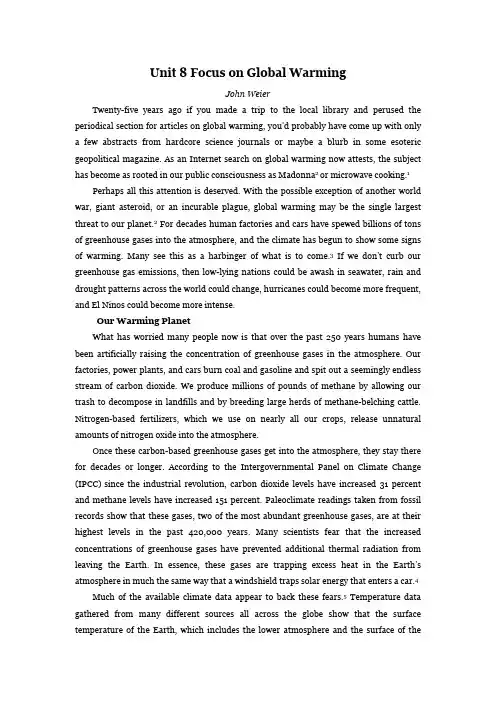
Unit 8 Focus on Global WarmingJohn WeierTwenty-five years ago if you made a trip to the local library and perused the periodical section for articles on global warming, you’d probably have come up with only a few abstracts from hardcore science journals or maybe a blurb in some esoteric geopolitical magazine. As an Internet search on global warming now attests, the subject has become as rooted in our public consciousness as Madonna2 or microwave cooking.1 Perhaps all this attention is deserved. With the possible exception of another world war, giant asteroid, or an incurable plague, global warming may be the single largest threat to our planet.2 For decades human factories and cars have spewed billions of tons of greenhouse gases into the atmosphere, and the climate has begun to show some signs of warming. Many see this as a harbinger of what is to come.3If we don’t curb our greenhouse gas emissions, then low-lying nations could be awash in seawater, rain and drought patterns across the world could change, hurricanes could become more frequent, and El Ninos could become more intense.Our Warming PlanetWhat has worried many people now is that over the past 250 years humans have been artificially raising the concentration of greenhouse gases in the atmosphere. Our factories, power plants, and cars burn coal and gasoline and spit out a seemingly endless stream of carbon dioxide. We produce millions of pounds of methane by allowing our trash to decompose in landfills and by breeding large herds of methane-belching cattle. Nitrogen-based fertilizers, which we use on nearly all our crops, release unnatural amounts of nitrogen oxide into the atmosphere.Once these carbon-based greenhouse gases get into the atmosphere, they stay there for decades or longer. According to the Intergovernmental Panel on Climate Change (IPCC)since the industrial revolution, carbon dioxide levels have increased 31 percent and methane levels have increased 151 percent. Paleoclimate readings taken from fossil records show that these gases, two of the most abundant greenhouse gases, are at their highest levels in the past 420,000 years. Many scientists fear that the increased concentrations of greenhouse gases have prevented additional thermal radiation from leaving the Earth. In essence, these gases are trapping excess heat in the Earth’s atmosphere in much the same way that a windshield traps solar energy that enters a car.4 Much of the available climate data appear to back these fears.5Temperature data gathered from many different sources all across the globe show that the surface temperature of the Earth, which includes the lower atmosphere and the surface of theocean, has risen dramatically over several decades. Worldwide measurements of sea level show a rise of 0.1 to 0.2 meters over the last century. That’s an increase of roughly 1℃every 4,000 years. Readings gathered from glaciers reveal a steady recession of the world’s continental glaciers. Taken together, all of these data suggest that over the last century the planet has experienced the largest increase in surface temperature in 1,000 years.Not surprisingly, many scientists speculate that such changes in the climate will probably result in hotter days and fewer cool days.6 According to the IPCC, land surface areas will increase in temperature over the summer months much more than the ocean. The mid-latitude to high-latitude regions in the Northern Hemisphere — areas such as the Continental United States, Canada, and Siberia — will likely warm the most. These regions could exceed mean global warming by as much as 40 percent.As far as human health is concerned, those hit hardest will probably be residents of poorer countries that do not have the funds to fend against changes in climate.7 A slight increase in heat and rain in equatorial regions would likely spark an increase in vector-borne diseases such as malaria. More intense rains and hurricanes could cause more severe flooding and more deaths in coastal regions and along riverbeds. Even a moderate rise in sea level could threaten the coastlines of low-lying islands such as the Maldives. All across the globe, hotter summers could lead to more cases of heatstroke and deaths among those who are vulnerable, such as older people with heart problems. The warmer temperatures may also lead to higher levels of near-surface ozone from cars and factories, which would likely cause more perilous air quality days and hospital admissions for those with respiratory problems.Taking ActionsFortunately, we can take actions to slow down global warming.8Global warming results primarily from human activities that release heat-trapping gases and particles into the air. The most important causes include the burning of fossil fuels such as coal, gas, and oil, and deforestation. To reduce the emission of heat-trapping gases like carbon dioxide, methane, and nitrous oxides, we can curb our consumption of fossil fuels, use technologies that reduce the amount of emissions wherever possible, and protect the forests in the world.We can also do things to mitigate the impacts of global warming and adapt to those most likely to occur,9 e.g., through careful planning and other strategies that reduce our vulnerability to global warming.But we can’t stop there. We are also advocating policies that will combat globalwarming over the long term, things like clean cars that run on alternative fuels, environmentally responsible renewable energy technologies, and stopping the clear-cutting of valuable forests.Clearly, global warming is a huge problem. It will take everyone — governments, industry, communities and individuals working together to make a real difference. Fortunately you can be part of them.关注全球气候变暖二十五年前,如果你想去当地的图书馆通过各种期刊搜索关于全球气候变暖的文章的话,很可能你只能找到一些刊登在核心自然科学期刊或非常专业的地理科学杂志上的同类文章的摘要。

托福阅读真题及答案:PASSAGE2托福阅读真题及答案:PASSAGE 2选择出国学习的人数越来越多,参加托福雅思考试无疑是进入国外大学的一块敲门砖。
以下是yjbys网店铺整理的关于托福阅读真题及答案:PASSAGE 2,供大家练习备考。
The geology of the Earth's surface is dominated by the particular properties of water. Present on Earth in solid, liquid, and gaseous states, water is exceptionally reactive. It dissolves, transports, and precipitates many chemical compounds and is constantly modifying the face of the Earth.Evaporated from the oceans, water vapor forms clouds, some of which are transported by wind over the continents. Condensation from the clouds provides the essential agent of continental erosion: rain. Precipitated onto the ground, the water trickles down to form brooks, streams, and rivers, constituting what are called the hydrographic network. This immense polarized network channels the water toward a single receptacle: an ocean. Gravity dominates this entire step in the cycle because water tends to minimize its potential energy by running from high altitudes toward the reference point, that is, sea level.The rate at which a molecule of water passes though the cycle is not random but is a measure of the relative size of the various reservoirs. If we define residence time as the average time for a water molecule to pass through one of the three reservoirs — atmosphere, continent, and ocean — we see that the times are very different. A water molecule stays, on average, eleven days in the atmosphere, one hundred years on a continent and forty thousand years in the ocean. This last figure shows the importance of the ocean as the principal reservoir of thehydrosphere but also the rapidity of water transport on the continents.A vast chemical separation process takes places during the flow of water over the continents. Soluble ions such as calcium, sodium, potassium, and some magnesium are dissolved and transported. Insoluble ions such as aluminum, iron, and silicon stay where they are and form the thin, fertile skin of soil on which vegetation can grow. Sometimes soils are destroyed and transported mechanically during flooding. The erosion of the continents thus results from two closely linked and interdependent processes, chemical erosion and mechanical erosion. Their respective interactions and efficiency depend on different factors.1. The word "modifying" in line 4 is closest in meaning to(A) changing(B) traveling(C) describing(D) destroying2. The word "which" in line 5 refers to(A) clouds(B) oceans(C) continents(D) compounds3. According to the passage , clouds are primarily formed by water(A) precipitating onto the ground(B) changing from a solid to a liquid state(C) evaporating from the oceans(D) being carried by wind4. The passage suggests that the purpose of the"hydrographic network" (line 8) is to(A) determine the size of molecules of water(B) prevent soil erosion caused by flooding(C) move water from the Earth's surface to the oceans(D) regulate the rate of water flow from streams and rivers5. What determines the rate at which a molecule of water moves through the cycle, as discussed in the third paragraph?(A) The potential energy contained in water(B) The effects of atmospheric pressure on chemical compounds(C) The amounts of rainfall that fall on the continents(D) The relative size of the water storage areas6. The word "rapidity" in line 19 is closest in meaning to(A) significance(B) method(C) swiftness(D) reliability7. The word "they" in line 24 refers to(A) insoluble ions(B) soluble ions(C) soils(D) continents8. All of the following are example of soluble ions EXCEPT(A) magnesium(B) iron(C) potassium(D) calcium9. The word "efficiency" in line 27 is closest in meaning to(A) relationship(B) growth(C) influence(D) effectiveness正确答案:AACCD CABD。
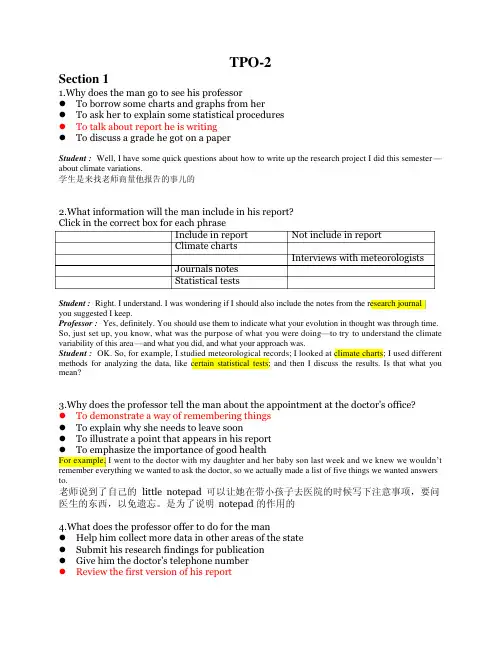
TPO-2Section 11.Why does the man go to see his professorTo borrow some charts and graphs from herTo ask her to explain some statistical proceduresTo talk about report he is writingTo discuss a grade he got on a paperStudent : Well, I have some quick questions about how to write up the research project I did this semester—about climate variations.学生是来找老师商量他报告的事儿的2.What information will the man include in his report?Click in the correct box for each phraseInclude in report Not include in reportClimate chartsInterviews with meteorologistsJournals notesStatistical testsStudent : Right. I understand. I was wondering if I should also include the notes from the research journalyou suggested I keep.Professor : Yes, definitely. You should use them to indicate what your evolution in thought was through time. So, just set up, you know, what was the purpose of what you were doing—to try to understand the climate variability of this area—and what you did, and what your approach was.Student : OK. So, for example, I studied meteorological records; I looked at climate charts; I used different methods for analyzing the data, like certain statistical tests; and then I discuss the results. Is that what you mean?3.Why does the professor tell the man about the appointment at the doctor's office?To demonstrate a way of remembering thingsTo explain why she needs to leave soonTo illustrate a point that appears in his reportTo emphasize the importance of good healthFor example, I wen t to the doctor with my daughter and her baby son last week and we knew we wouldn’t remember everything we wanted to ask the doctor, so we actually made a list of five things we wanted answers to.老师说到了自己的little notepad可以让她在带小孩子去医院的时候写下注意事项,要问医生的东西,以免遗忘。
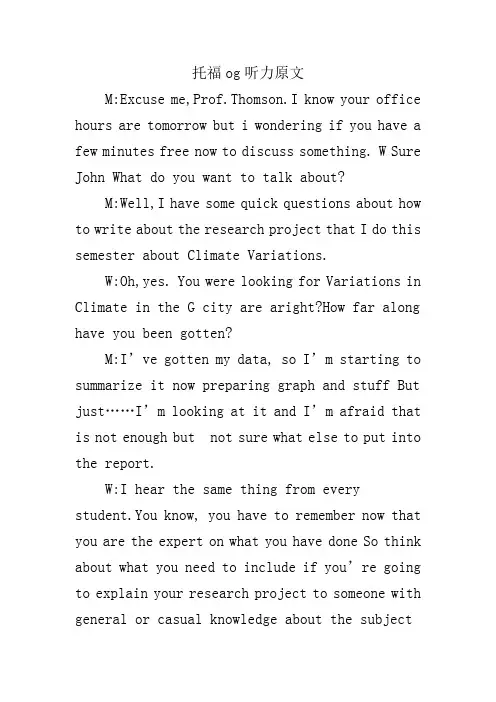
托福og听力原文M:Excuse me,Prof.Thomson.I know your office hours are tomorrow but i wondering if you have a few minutes free now to discuss something. W Sure John What do you want to talk about?M:Well,I have some quick questions about how to write about the research project that I do this semester about Climate Variations.W:Oh,yes. You were looking for Variations in Climate in the G city are aright?How far along have you been gotten?M:I’ve gotten my data, so I’m starting to summarize it now preparing graph and stuff But just……I’m looking at it and I’m afraid that is not enough but not sure what else to put into the report.W:I hear the same thing from every student.You know, you have to remember now that you are the expert on what you have done So think about what you need to include if you’re going to explain your research project to someone with general or casual knowledge about the subjectlike your parents.That’s usually my rule_Would my parents understand this. M:Uh, I get it.W:I hope you can recognize by my thing how much you do know about the subject.M:Right I understand.I was wondering if I should also include the notes from the research journals you suggest I keep.W:Yes,definitely.You should use them to indicate what your evolution and thought was through time. So just set up you know what was the purpose of what you were doing.To try to understand the climate variability of this area.What you did and what your approach was.M:o.So.for example study meteorological records.I look at climate charts.I use different methods for analyzing the data like certain statistic tests and then I discuss the results.Is that what you mean?W:Yes.that’s right.You should include all of that.The statistical tests are specially important, and also be sure you include good reference section where all your published andunpublished data came from.Could you have a lot of unpublished climate data?M:Um.Something just came out of my mind and went out the other sideW:It happens to me a lot. So,I have come up with a pretty good memory management tool.] carry a little pad with me over time and jot down questions and ideas that I don’t want to forget For example, I went to the doctor with my daughter and her baby son last week and we know we wouldn’t remember everything we want to ask the d or so we actually made at least five things we want answers to.M:Notepad is a good idea.Since I’m so busy now, at the end of this semester I getting pretty forgetful these days.How can I just remember what I going to say be fore W:Good, I was hoping you come up with it.M:Yes. It ends up that I have data more than just in the area so I also include some regional data in the report.With everything else it should be a pretty good indicate of climate of this partof state.W: Sounds good.I'll be happy to look over a draft version before you hand the final copy if you wish.M:Great.I plan to get you the draft of paper by next Friday Thanks very much.Well see you W: O.。
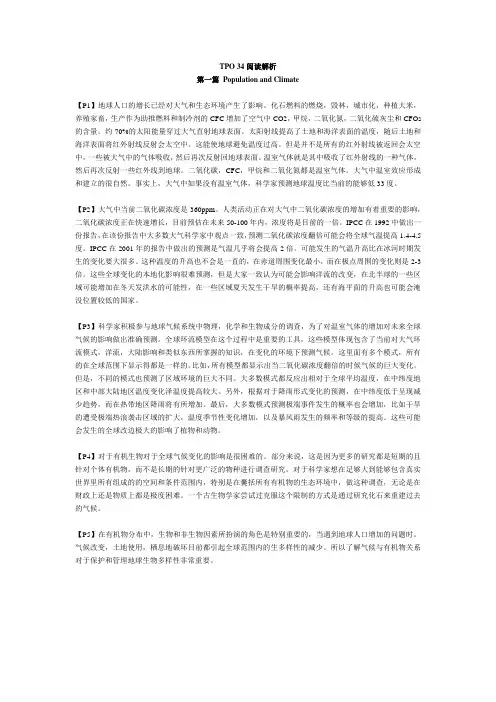
TPO 34阅读解析第一篇Population and Climate【P1】地球人口的增长已经对大气和生态环境产生了影响。
化石燃料的燃烧,毁林,城市化,种植大米,养殖家畜,生产作为助推燃料和制冷剂的CFC增加了空气中CO2,甲烷,二氧化氮,二氧化硫灰尘和CFOs 的含量。
约70%的太阳能量穿过大气直射地球表面。
太阳射线提高了土地和海洋表面的温度,随后土地和海洋表面将红外射线反射会太空中。
这能使地球避免温度过高。
但是并不是所有的红外射线被返回会太空中,一些被大气中的气体吸收,然后再次反射回地球表面。
温室气体就是其中吸收了红外射线的一种气体,然后再次反射一些红外线到地球。
二氧化碳,CFC,甲烷和二氧化氮都是温室气体。
大气中温室效应形成和建立的很自然。
事实上,大气中如果没有温室气体,科学家预测地球温度比当前的能够低33度。
【P2】大气中当前二氧化碳浓度是360ppm。
人类活动正在对大气中二氧化碳浓度的增加有着重要的影响,二氧化碳浓度正在快速增长,目前预估在未来50-100年内,浓度将是目前的一倍。
IPCC在1992中做出一份报告,在该份报告中大多数大气科学家中观点一致,预测二氧化碳浓度翻倍可能会将全球气温提高1.4-4.5度。
IPCC在2001年的报告中做出的预测是气温几乎将会提高2倍。
可能发生的气温升高比在冰河时期发生的变化要大很多。
这种温度的升高也不会是一直的,在赤道周围变化最小,而在极点周围的变化则是2-3倍。
这些全球变化的本地化影响很难预测,但是大家一致认为可能会影响洋流的改变,在北半球的一些区域可能增加在冬天发洪水的可能性,在一些区域夏天发生干旱的概率提高,还有海平面的升高也可能会淹没位置较低的国家。
【P3】科学家积极参与地球气候系统中物理,化学和生物成分的调查,为了对温室气体的增加对未来全球气候的影响做出准确预测。
全球环流模型在这个过程中是重要的工具。
这些模型体现包含了当前对大气环流模式,洋流,大陆影响和类似东西所掌握的知识,在变化的环境下预测气候。
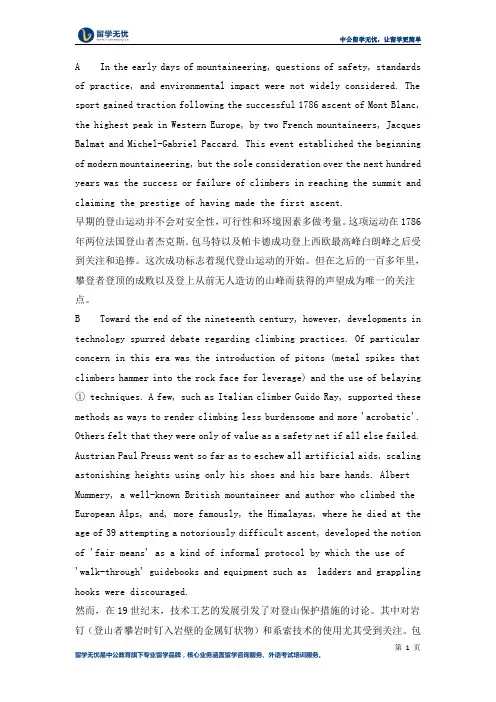
A In the early days of mountaineering,questions of safety,standards of practice,and environmental impact were not widely considered.The sport gained traction following the successful1786ascent of Mont Blanc, the highest peak in Western Europe,by two French mountaineers,Jacques Balmat and Michel-Gabriel Paccard.This event established the beginning of modern mountaineering,but the sole consideration over the next hundred years was the success or failure of climbers in reaching the summit and claiming the prestige of having made the first ascent.早期的登山运动并不会对安全性,可行性和环境因素多做考量。
这项运动在1786年两位法国登山者杰克斯.包马特以及帕卡德成功登上西欧最高峰白朗峰之后受到关注和追捧。
这次成功标志着现代登山运动的开始。
但在之后的一百多年里,攀登者登顶的成败以及登上从前无人造访的山峰而获得的声望成为唯一的关注点。
B Toward the end of the nineteenth century,however,developments in technology spurred debate regarding climbing practices.Of particular concern in this era was the introduction of pitons(metal spikes that climbers hammer into the rock face for leverage)and the use of belaying ①techniques.A few,such as Italian climber Guido Ray,supported these methods as ways to render climbing less burdensome and more'acrobatic'. Others felt that they were only of value as a safety net if all else failed. Austrian Paul Preuss went so far as to eschew all artificial aids,scaling astonishing heights using only his shoes and his bare hands.Albert Mummery,a well-known British mountaineer and author who climbed the European Alps,and,more famously,the Himalayas,where he died at the age of39attempting a notoriously difficult ascent,developed the notion of'fair means'as a kind of informal protocol by which the use of'walk-through'guidebooks and equipment such as ladders and grappling hooks were discouraged.然而,在19世纪末,技术工艺的发展引发了对登山保护措施的讨论。
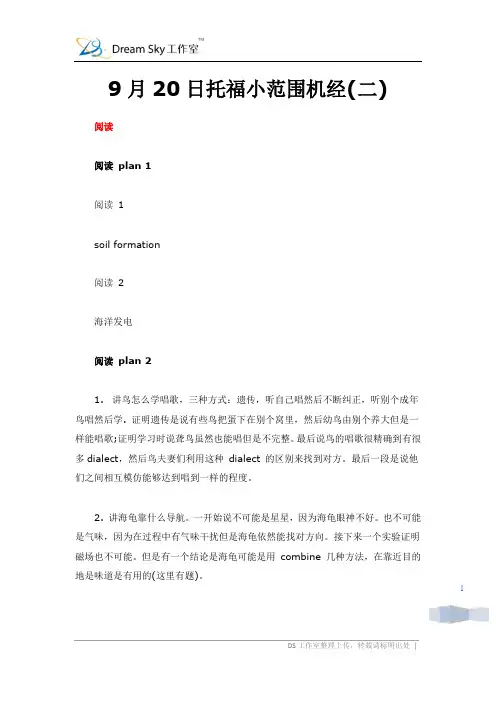
9月20日托福小范围机经(二) 阅读阅读plan 1阅读1soil formation阅读 2海洋发电阅读plan 21. 讲鸟怎么学唱歌,三种方式:遗传,听自己唱然后不断纠正,听别个成年鸟唱然后学. 证明遗传是说有些鸟把蛋下在别个窝里,然后幼鸟由别个养大但是一样能唱歌;证明学习时说聋鸟虽然也能唱但是不完整。
最后说鸟的唱歌很精确到有很多dialect,然后鸟夫妻们利用这种dialect 的区别来找到对方。
最后一段是说他们之间相互模仿能够达到唱到一样的程度。
2. 讲海龟靠什么导航。
一开始说不可能是星星,因为海龟眼神不好。
也不可能是气味,因为在过程中有气味干扰但是海龟依然能找对方向。
接下来一个实验证明磁场也不可能。
但是有一个结论是海龟可能是用combine 几种方法,在靠近目的地是味道是有用的(这里有题)。
12最后一种解释,是海龟体内的一种 DNA ,它能记录海龟被孵化出的地点(也就是他们去的地方),并且由母海龟遗传给小海龟。
最后说有一个例子可以证明:从前在加勒比海的一个地方有很多绿海龟,但是后来捕杀很严重海龟们就不去了;近几年虽然又保护起来了但是海龟们来得仍然很少。
3. local wind 三篇里面最简单的一个,基本上地理过关的不用看文章就能做题。
开头先解释什么是 local wind ,并说其实并不 local 而是一个大系统的一部分,有题。
后面主要讲了两种风:sea-land wind 和 valley-mountain wind 。
白天陆地升温快形成低气压,于是风从海往陆地吹,能够降低陆地温度;晚上陆地降温快形成高气压于是风从陆地往海吹。
这一现象跟纬度有关系,热带最明显,中纬度就不那么强烈,高纬度就几乎注意不到。
第二种风,白天山面的空气受热快向上爬升形成 valleywind ,这个风会产生雷阵雨;晚上反之形成 mountain wind (这里有题问 mountain wind 的原理是什么),这个风很冷会冻伤农作物(有题)。
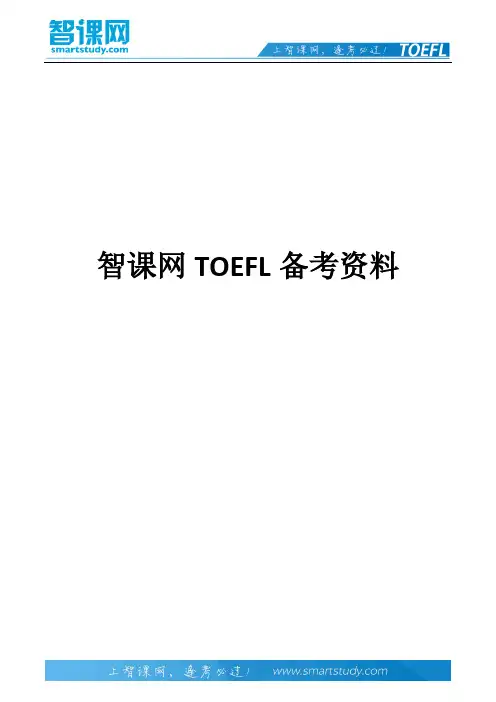
智课网TOEFL备考资料托福TPO阅读真题及译文:城市气候摘要:托福TPO阅读真题素材及译文:城市气候,托福TPO阅读真题是非常珍贵的复习材料和练习素材,考托福的考生要好好利用,尤其对于托福阅读不太好的同学,一定要多加练习。
本文小马小编为各位考生准备了托福TPO阅读真题及译文:城市气候,希望考生能够充分利用。
托福 TPO阅读真题:Urban Climates第一段:托福TPO阅读原文:The city is an extraordinary processor of mass and energy and has its own metabolism. A daily input of water, food, and energy of various kinds is matched by an output of sewage, solid waste, air pollutants, energy, and materials that have been transformed in some way. The quantities involved are enormous. Many aspects of this energy use affect the atmosphere of a city, particularly in the production of heat.托福TPO阅读翻译:冬天城市所产生的热量可以达到或超过其从太阳那里接收的热量。
所有用来供暖的热量最后都扩散至周围的空气中,这个过程在那些隔热效果差的房屋里进行得最快。
一辆汽车所产生的热量足以为一个普通的房屋供暖,如果房屋隔热效果好,一个成年人产生的热量就足以让其保暖了。
因此,即使没有任何工业产热,城市地区也会比它周围的乡村地区更暖和。
第二段:托福TPO阅读原文:In winter the heat produced by a city can equal or surpass the amount of heat available from the Sun. All the heatthat warms a building eventually transfers to the surrounding air, a process that is quickest where houses are poorly insulated. But an automobile produces enough heat to warm an average house in winter, and if a house were perfectly insulated, one adult could also produce more than enough heat to warm it. Therefore, even without any industrial production of heat, an urban area tends to be warmer than the countryside that surrounds it.托福TPO阅读翻译:在中国,每一个朝代陶瓷的功能和地位都是不同的,所以,根据它们的质量和制作年代的不同,可以是实用器物、陪葬品、贸易收藏品,甚至是礼器。
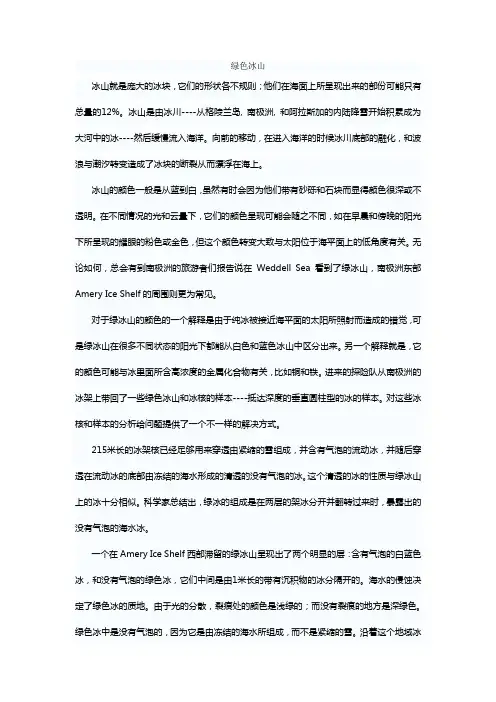
绿色冰山冰山就是庞大的冰块,它们的形状各不规则;他们在海面上所呈现出来的部份可能只有总量的12%。
冰山是由冰川----从格陵兰岛, 南极洲, 和阿拉斯加的内陆降雪开始积累成为大河中的冰----然后缓慢流入海洋。
向前的移动,在进入海洋的时候冰川底部的融化,和波浪与潮汐转变造成了冰块的断裂从而漂浮在海上。
冰山的颜色一般是从蓝到白,虽然有时会因为他们带有砂砾和石块而显得颜色很深或不透明。
在不同情况的光和云量下,它们的颜色呈现可能会随之不同,如在早晨和傍晚的阳光下所呈现的耀眼的粉色或金色,但这个颜色转变大致与太阳位于海平面上的低角度有关。
无论如何,总会有到南极洲的旅游者们报告说在Weddell Sea看到了绿冰山,南极洲东部Amery Ice Shelf的周围则更为常见。
对于绿冰山的颜色的一个解释是由于纯冰被接近海平面的太阳所照射而造成的错觉,可是绿冰山在很多不同状态的阳光下都能从白色和蓝色冰山中区分出来。
另一个解释就是,它的颜色可能与冰里面所含高浓度的金属化合物有关,比如铜和铁。
进来的探险队从南极洲的冰架上带回了一些绿色冰山和冰核的样本----抵达深度的垂直圆柱型的冰的样本。
对这些冰核和样本的分析给问题提供了一个不一样的解决方式。
215米长的冰架核已经足够用来穿透由紧缩的雪组成,并含有气泡的流动冰,并随后穿透在流动冰的底部由冻结的海水形成的清透的没有气泡的冰。
这个清透的冰的性质与绿冰山上的冰十分相似。
科学家总结出,绿冰的组成是在两层的架冰分开并翻转过来时,暴露出的没有气泡的海水冰。
一个在Amery Ice Shelf西部滞留的绿冰山呈现出了两个明显的层:含有气泡的白蓝色冰,和没有气泡的绿色冰,它们中间是由1米长的带有沉积物的冰分隔开的。
海水的侵蚀决定了绿色冰的质地。
由于光的分散,裂痕处的颜色是浅绿的;而没有裂痕的地方是深绿色。
绿色冰中是没有气泡的,因为它是由冻结的海水所组成,而不是紧缩的雪。
沿着这个地域冰架的边缘,可以发现,带有绿色色素的单细胞生物超级多,而且海水里面含有它们丰硕的分解有机物质。
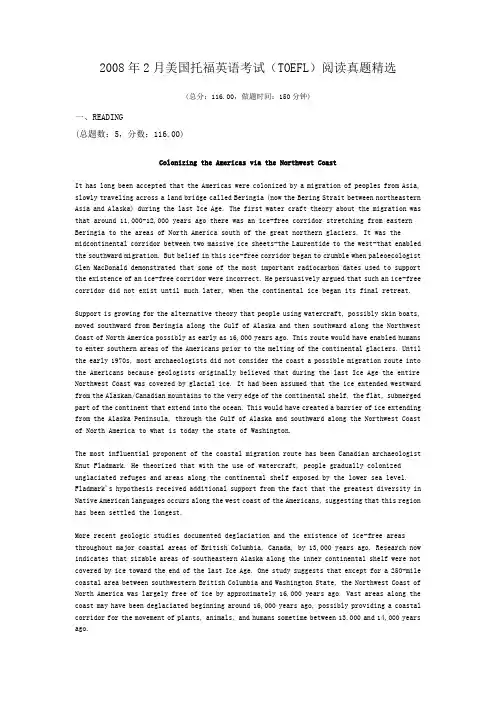
2008年2月美国托福英语考试(TOEFL)阅读真题精选(总分:116.00,做题时间:150分钟)一、READING(总题数:5,分数:116.00)Colonizing the Americas via the Northwest CoastIt has long been accepted that the Americas were colonized by a migration of peoples from Asia, slowly traveling across a land bridge called Beringia (now the Bering Strait between northeastern Asia and Alaska) during the last Ice Age. The first water craft theory about the migration was that around 11,000-12,000 years ago there was an ice-free corridor stretching from eastern Beringia to the areas of North America south of the great northern glaciers. It was the midcontinental corridor between two massive ice sheets-the Laurentide to the west-that enabled the southward migration. But belief in this ice-free corridor began to crumble when paleoecologist Glen MacDonald demonstrated that some of the most important radiocarbon dates used to support the existence of an ice-free corridor were incorrect. He persuasively argued that such an ice-free corridor did not exist until much later, when the continental ice began its final retreat.Support is growing for the alternative theory that people using watercraft, possibly skin boats, moved southward from Beringia along the Gulf of Alaska and then southward along the Northwest Coast of North America possibly as early as 16,000 years ago. This route would have enabled humans to enter southern areas of the Americans prior to the melting of the continental glaciers. Until the early 1970s, most archaeologists did not consider the coast a possible migration route into the Americans because geologists originally believed that during the last Ice Age the entire Northwest Coast was covered by glacial ice. It had been assumed that the ice extended westward from the Alaskan/Canadian mountains to the very edge of the continental shelf, the flat, submerged part of the continent that extend into the ocean. This would have created a barrier of ice extending from the Alaska Peninsula, through the Gulf of Alaska and southward along the Northwest Coast of North America to what is today the state of Washington.The most influential proponent of the coastal migration route has been Canadian archaeologist Knut Fladmark. He theorized that with the use of watercraft, people gradually colonized unglaciated refuges and areas along the continental shelf exposed by the lower sea level. Fladmark's hypothesis received additional support from the fact that the greatest diversity in Native American languages occurs along the west coast of the Americans, suggesting that this region has been settled the longest.More recent geologic studies documented deglaciation and the existence of ice-free areas throughout major coastal areas of British Columbia, Canada, by 13,000 years ago. Research now indicates that sizable areas of southeastern Alaska along the inner continental shelf were not covered by ice toward the end of the last Ice Age. One study suggests that except for a 250-mile coastal area between southwestern British Columbia and Washington State, the Northwest Coast of North America was largely free of ice by approximately 16,000 years ago. Vast areas along the coast may have been deglaciated beginning around 16,000 years ago, possibly providing a coastal corridor for the movement of plants, animals, and humans sometime between 13,000 and 14,000 years ago.The coastal hypothesis has gained increasing support in recent years because the remains of large land animals, such as caribou and brown bears, have been found in southeastern Alaska dating between 10,000 and 12,500 years ago. This is the time period in which most scientists formerly believed the area to be inhospitable for humans. It has been suggested that if the environment were capable of supporting breeding populations of bears, there would have been enough food resources to support humans. Fladmark and others believe that the first human colonization of America occurred by boat along the Northwest Coast during the very late Ice Age, possibly as early as 14,000 years ago. The most recent geologic evidence indicates that it may have been possible for people to colonize ice-free regions along the continental shelf that were still exposed by the lower sea level between 13,000 and 14,000 ago.The coastal hypothesis suggests an economy based on marine mammal hunting, saltwater fishing gathering, and the use of watercraft. Because of the barrier of ice to the east, the Pacific Ocean to the west, and populated areas to the north, there may have been a greater impetus for people to move in a southerly direction(分数:24)(1).According to paragraph 1, the theory that people first migrated to the Americans by way of an ice-free corridor was seriously called into question by(分数:2)A.paleoecologist Glen MacDonald's argument that the original migration occurred much later than had previously been believedB.the demonstration that certain previously accepted radiocarbon dates were incorrect √C.evidence that the continental ice began its final retreat much later than had previously been believedD.research showing that the ice-free corridor was not as long lasting as had been widely assumed 解析:参考译文:从西海岸殖民美洲这种观念被人们接受很长时间了:美洲被一群来自亚洲的移民殖民统治着,他们在上一个冰河时代缓慢的跨越了一个叫做白令的大陆桥(现在白令海峡位于东北亚和阿拉斯加之间)。
GRE之OG2阅读真题精选GRE阅读真题之OG2 Passage 31OG-2Passage 31Recently an unusually high number of dolphins have been found dead of infectious diseases, and most of these had abnormally high tissue concentrations of certain compounds that, even in low concentrations, reduce dolphins’ resistance to infection. The only source of these compounds in the dolphins’ environment is boat paint. Therefore, since dolphins rid their bodies of the compounds rapidly once exposure ceases, their mortality rate should decline rapidly if such boat paints are banned.1. Which of the following, if true, most strengthens the argument?A. The levels of the compounds typically used in boat paints today are lower than they were in boat paints manufactured a decade ago.B. In high concentrations, the compounds are toxic to many types of marine animals.C. The compounds break down into harmless substances after a few months of exposure to water or air.D. High tissue levels of the compounds have recently been found in some marine animals, but there is no record of any of those animals dying in unusually large numbers recently.E. The compounds do not leach out of the boat paint if the paint is applied exactly in accordance with the manufacturer’s directions.GRE阅读真题之OG2 Passage 32OG-2Passage 32The work of English writer Aphra Behn (1640–1689) changed markedly during the 1680s, as she turned from writing plays to writing prose narratives. According to literary critic Rachel Carnell, most scholars view this change as primarily motivated by financial considerations: earning a living by writing for the theatre became more difficult in the 1680s, so Behn tried various other types of prose genres in the hope of finding another lucrative medium. In fact, a long epistolary scandal novel that she wrote in the mid-1680s sold quite well. Yet, as Carnell notes, Behn did not repeat this approach in her other prose works; instead, she turned towriting shorter, more serious novels, even though only about half of these were published during her lifetime. Carnell argues that Behn, whose stage productions are primarily comedies, may have turned to an emerging literary form, the novel, in a conscious attempt to criticize, and subvert for her own ends, the conventions and ideology of a well-established form of her day, the dramatic tragedy.Carnell acknowledges that Behn admired the skill of such contemporary writers of dramatic tragedy as John Dryden, and that Behn’s own comic stage productions displayed the same partisanship for the reigning Stuart monarchy that characterized most of the politically oriented dramatic tragedies of her day. However, Carnell argues that Behn took issue with the way in which these writers and plays defined the nature of tragedy. As prescribed by Dryden, tragedy was supposed to concern a heroic man who is a public figure and who undergoes a fall that evokes pity from the audience. Carnell points out that Behn’s tragic novels focus instead on the plight of little-known women and the private world of the household; even in her few novels featuring male protagonists, Behn insists on the importance of the crimes these otherwise heroic figures commit in the domestic sphere.Moreover, according to Carnell, Behn questioned the view promulgated by monarchist dramatic tragedies such as Dryden’s: that the envisioned “public” political ideal—passive obedience to the nation’s king—ought to be mirrored in the private sphere, with family members wholly obedient to a male head of household. Carnell sees Behn’s novels not only as rejecting the model of patriarchal and hierarchical family order, but also as warning that insisting on such a parallel can result in real tragedy befalling the members of the domestic sphere. According to Carnell, Behn’s choice of literary form underscores the differences between her own approach to crafting a tragic story and that taken in the dramatic tragedies, with their artificial distinction between the public and private spheres. Behn’s novels engage in the political dialogue of her era by demonstrating that the good of the nation ultimately encompasses more than the good of the public figures who rule it.1. The passage is primarily concerned withA. tracing how Behn’s view of the nature of tragedy changed over timeB. explaining one author’s view of Behn’s contribu tion to the development of an emerging literary formC. differentiating between the early and the late literary works of BehnD. contrasting the approaches to tragedy taken by Behn and by DrydenE. presenting one scholar’s explanation for a maj or development in Behn’s literary career2. The passage suggests that Carnell sees Behn’s novels featuring male protagonists as differing from dramatic tragedies such as Dryden’s featuring male protagonists in that the formerA. depict these characters as less than heroic in their public actionsB. emphasize the consequences of these characters’ actions in the private sphereC. insist on a parallel between the public and the private spheresD. are aimed at a predominantly female audienceE. depict family members who disobey these protagonists3. The passage suggests that Carnell believes Behn held which of the following attitudes about the relationship between the private and public spheres?A. The private sphere is more appropriate than is the publicsphere as the setting for plays about political events.B. The structure of the private sphere should not replicate the hierarchical order of the public sphere.C. Actions in the private sphere are more fundamental to ensuring the good of the nation than are actions in the public sphere.D. Crimes committed in the private sphere are likely to cause tragedy in the public sphere rather than vice versa.E. The private sphere is the mirror in which issues affecting the public sphere can most clearly be seen.4. It can be inferred from the passage that the “artificial distinction” (line 53-54) refers to theA. practice utilized in dramatic tragedies of providing different structural models for the public and the private spheresB. ideology of many dramatic tragedies that advocate passive obedience only in the private sphere and not in the public sphereC. convention that drama ought to concern events in the public sphere and that novels ought to concern events in the private sphereD. assumption made by the authors of conventionaldramatic tragedies that legitimate tragic action occurs only in the public sphereE. approach taken by the dramatic tragedies in depicting male and female characters differently, depending on whether their roles were public or privateGRE阅读真题之OG2 Passage 33OG-2Passage 33Computers cannot accurately predict climate change unless the mathematical equations fed into them adequately capture the natural meteorological processes they are intended to simulate. Moreover, there are processes that influence climate, such as modifications in land use, that scientists do not know how to simulate. The failure to incorporate such a process into a computer climate model can lead the model astray because a small initial effect can initiate a feedback cycle: a perturbation in one variable modifies a second variable, which in turn amplifies the original disturbance. An increase in temperature, for example, can boost the moisture content of the atmosphere, which then causes further warming because water vapor is a greenhouse gas.For the following question, consider each of the choicesseparately and choose all that apply.1. The passage mentions which of the following as adversely affecting the accuracy of computer predictions of climate change?A. Failure to allow for some of the processes that influence climateB. Mathematical equations that do not accurately reflect natural phenomenaC. An overestimate of the role of feedback cycles2. In the context in which it appears, “amplifies” (line 11) most nearly meansA. exacerbatesB. explicatesC. expatiatesD. adds detail toE. makes louderGRE阅读真题之OG2 Passage 34OG-2Passage 34Extensive housing construction is underway in Pataska Forest, the habitat of a large population of deer. Because deer feed at the edges of forests, these deer will be attracted to the spacesalongside the new roads being cut through Pataska Forest to serve the new residential areas. Consequently, once the housing is occupied, the annual number of the forest’s deer hit by cars will be much higher than before construction started.1. Which of the following is an assumption on which the argument depends?A. The number of deer hit by commercial vehicles will not increase significantly when the housing is occupied.B. Deer will be as attracted to the forest edge around new houses as to the forest edge alongside roads.C. In years past, the annual number of deer that have been hit by cars on existing roads through Pataska Forest has been very low.D. The development will leave sufficient forest to sustain a significant population of deer.E. No deer hunting will be allowed in Pataska Forest when the housing is occupied.GRE阅读真题之OG2 Passage 35OG-2Passage 35While chocolate was highly esteemed in Mesoamerica,where it originated, its adoption in Europe was initially slow. There is a common belief that Europeans needed t o “transform” chocolate to make it appetizing. However, while Spaniards did put sugar, which was unknown to indigenous Americans, into chocolate beverages, this additive was not completely innovative. Mesoamericans were already sweetening chocolate with honey, and the step from honey to sugar—increasingly more available than honey because of expanding sugar plantations in the Americas—is a small one. Likewise, although Spaniards adjusted Mesoamerican recipes by using European spices, the spices chosen suggest an attempt to replicate harder-to-find native flowers. There is no indication the Spaniards deliberately tried to change the original flavor of chocolate.1. The author of the passage refers to the use of honey primarily toA. identify the origins of an additive previously untried by EuropeansB. present an example of a product that was unknown to EuropeansC. correct the misapprehension that Mesoamericans used a sweetener that was not available in EuropeD. provide an example of an ingredient that was in the process of being displaced by a substituteE. explain why the Spanish use of sugar in chocolate was nota sign of a need to transform chocolate2. Which sentence presents a misconception that the passage challenges?A. The second (“There is 。
GRE之OG2阅读真题精选整合在备考GRE阅读的过程中,练真题是必不行少的流程,我就和大家共享,来观赏一下吧。
GRE阅读真题之OG2 Passage 21OG-2Passage 21Even after numerous products made with artificial sweeteners became available, sugar consumption per capita continued to rise. Now manufacturers are introducing fat-free versions of various foods that they claim have the taste and texture of the traditional high-fat versions. Even if the manufacturers’ claim is true, given that the availability of sugar-free foods did not reduce sugar consumption, it is unlikely that the availability of these fat-free foods will reduce fat consumption.1. Which of the following, if true, most seriously undermines the argument?A. Several kinds of fat substitute are available to manufacturers, each of which gives a noticeably different taste and texture to products that contain it.B. The products made with artificial sweeteners did not taste like products made with sugar.C. The foods brought out in sugar-free versions did not generallyhave reduced levels of fat, but many of the fat-free versions about to be introduced are low in sugar.D. People who regularly consume products containing artificial sweeteners are more likely than others to consume fat-free foods.E. Not all foods containing fat can be produced in fat-free versions.GRE阅读真题之OG2 Passage 22OG-2Passage 22Recent studies of sediment in the North Atlantic’s deep waters reveal possible cyclical patterns in the history of Earth’s climate. The rock fragments in these sediments are too large to have been transported there by ocean currents; they must have reached their present locations by traveling in large icebergs that floated long distances from their point of origin before melting. Geologist GerardBond noticed that some of the sediment grains were stained with iron oxide, evidence that they originated in locales where glaciers had overrun outcrops of red sandstone. Bond’s detailed analysis of deep-water sediment cores showed changes in the mix of sediment sources over time: the proportion of these red-stained grains fluctuated back and forth from lows of 5 percent to highs of about 17 percent, and these fluctuations occurred in a nearly regular 1,500-year cycle.Bond hypothesized that the alternating cycles might be evidence ofchanges in ocean-water circulation and therefore in Earth’s climate. He knew that the sources of the red-stained grains were generally closer to the North Pole than were the places yielding a high proportion of “clean” grains. At certain times, apparently, more icebergs from the Arctic Ocean in the far north were traveling south well into the North Atlantic before melting and shedding their sediment.Ocean waters are constantly moving, and water temperature is both a cause and an effect of this movement. As water cools, it becomes denser and sinks to the ocean’s bottom. During some periods, the bottom layer of the world’s oceans comes from cold, dense water sinking in the far North Atlantic. This causes the warm surface waters of the Gulf Stream to be pulled northward. Bond realized that during such periods, the influx of these warm surface waters into northern regions could cause a large proportion of the icebergs that bear red grains to melt before traveling very far into the North Atlantic. But sometimes the ocean’s dynamic changes, and waters from the Gulf Stream do not travel northward in this way. During these periods, surface waters in the North Atlantic would generally be colder, permitting icebergs bearing red-stained grains to travel farther south in the North Atlantic before melting and depositing their sediment.The onset of the so-called Little Ice Age (1300-1860), which followed the Medieval Warm Period of the eighth through tenthcenturies, may represent the most recent time that the ocean’s dynamic changed in this way. If ongoing climate-history studies support Bond’s hypothesis of 1,500-year cycles, scientists may establish a major natural rhythm in Earth’s temperatures that could then be extrapolated into the future. Because the midpoint of the Medieval Warm Period was about A.D. 850, an extension of Bond’s cycles would place the midpoint of the next warm interval in the twenty-fourth century.1. According to the passage, which of the following is true of the rock fragments contained in the sediments studied by Bond?A. The majority of them are composed of red sandstone.B. They must have reached their present location over 1,500 years ago.C. They were carried by icebergs to their present location.D. Most of them were carried to their present location during a warm period in Earth’s climatic history.E. They are unlikely to have been carried to their present location during the Little Ice Age.2. In the final paragraph of the passage (lines 47-59), the author is concerned primarily withA. answering a question about Earth’s climatic historyB. pointing out a potential flaw in Bond’s hypothesisC. suggesting a new focus for the study of ocean sedimentsD. tracing the general history of Earth’s climateE. discussing possible implications of Bond’s hypothesis3. According to the passage, Bond hypothesized that which of the following circumstances would allow red-stained sediment grains to reach more southerly latitudes?A. Warm waters being pulled northward from the Gulf StreamB. Climatic conditions causing icebergs to melt relatively quicklyC. Icebergs containing a higher proportion of iron oxide than usualD. The formation of more icebergs than usual in the far northE. The presence of cold surface waters in the North Atlantic4. It can be inferred from the passage that in sediment cores from the North Atlantic’s deep waters, the portions that correspond to the Little Ice AgeA. differ very little in composition from the portions that correspond to the MedievalWarm PeriodB. fluctuate significantly in composition between the portions corresponding to the 1300s and the portions corresponding to the 1700sC. would be likely to contain a proportion of red-stained grains closer to 17 percent than to 5 percentD. show a much higher proportion of red-stained grains in cores extracted from the far north of the North Atlantic than in cores extracted from further southE. were formed in part as a result of Gulf Stream waters having been pulled northwardGRE阅读真题之OG2 Passage 23OG-2Passage 23As an example of the devastation wrought on music publishers by the photocopier, one executive noted that for a recent choral festival with 1,200 singers, the festival’s organizing committee purchased only 12 copies of the music published by her company that was performed as part of the festival.1. Which of the following, if true, most seriously weakens the support the example lends to the executive’s contention that music publishers have been devastated by the photocopier?A. Only a third of the 1,200 singers were involved in performing the music published by the executive’s company.B. Half of the singers at the festival had already heard the music they were to perform before they began to practice for the festival.C. Because of shortages in funding, the organizing committee of the choral festival required singers to purchase their own copies of the music performed at the festival.D. Each copy of music that was performed at the festival was shared by two singers.E. As a result of publicity generated by its performance at the festival, the type of music performed at the festival became more widely known.GRE阅读真题之OG2 Passage 24OG-2Passage 24A tall tree can transport a hundred gallons of water a day from its roots deep underground to the treetop. Is this movement propelled by pulling the water from above or pushing it from below? The pull mechanism has long been favored by most scientists. First proposed in the late 1800s, the theory relies on a property of water not commonly associated with fluids: its tensile strength. Instead of making a clean break, water evaporating from treetops tugs on the remaining water molecules, with that tug extending from molecule to molecule all the way down to the roots. The tree itself does not actually push or pull; all the energy for lifting water comes from the sun’s evaporative power.1. Which of the following statements is supported by the passage?A. The pull theory is not universally accepted by scientists.B. The pull theory depends on one of water’s physical properties.C. The pull theory originated earlier than did the push theory.2. The passage provides information on each of the following EXCEPTA. when the pull theory originatedB. the amount of water a tall tree can transportC. the significance of water’s tensile strength in the pull theoryD. the role of the sun in the pull theoryE. the mechanism underlying water’s tensile strengthGRE阅读真题之OG2 Passage 25OG-2Passage 25While the influence of British magazines in shaping public opinion predates the nineteenth century, it was during the 1800s that mass distribution became possible and an explosion in periodical readership occurred, vastly increasing magazines’ opinion-shaping powers. The role of magazines as arbiters of nineteenth-century taste is seen in their depictions of the London theater. The magazines accorded some legitimacy to East End working-class theaters that mirrored the format of the fashionable West End theaters serving middle-and upper-class audiences. However, the magazines also depicted music halls—which competed for patronage with all theaters—as places where crass entertainment corrupted spectators’ taste and morals. Finally, they suggested that popular demand for substandard fare created a market unfriendly to higher expressions of dramatic art.1. The author of the passage attributes the influence of Britishperiodicals in shaping public opinion in the nineteenth century in part toA. a growing public interest in reading opinion piecesB. an increase in the relative number of readers from the middle and upper classesC. changes in the way in which magazines were distributedD. magazines’ increased coverage of theater and popular entertainmentE. changes in magazine format that attracted a wider readership2. The author of the passage mentions East End working-class theaters primarily in order toA. illustrate a point about the ability of magazines to sway public opinionB. contrast the kinds of entertainment presented in East End and West End theatersC. make a point about how spectators’ tastes influenced the offerings at different kinds of theatersD. explain how magazines chose which kinds of entertainment to coverE. identify factors that helped make certain theaters fashionable3. In the context in which it appears, “accorded” (line 9) most nearly meansA. reconciledB. revealedC. grantedD. verifiedE. maintained21B22CEEC23C24ABE25CAC11。
智 课 网 托 福 备 考 资 料托福真题有关“冰川”话题词汇总结-智课教育旗下智课教育本文和大家分享的是有关冰川话题的托福真题词汇总结,供考生参考使用,希望考生能够认真备考,预祝考生能够考出好成绩。
作为学生备考托福的唯一真题资料和ETS官方出题机构作为代表性的试卷,托福TPO和OG中的词汇无疑是托福唯一可以参照的托福真题词汇。
基于托福中已经的26套TPO真题和OG官方指南中的试卷为素材,为大家分析托福考试冰川话题的词汇。
托福考试中直接涉及到冰川的话题文章一共有7篇,它们分别是:阅读TPO-19-3:Discovering the Ice Ages 发现冰期TPO-15-3:Glacier Formation冰川的形成OG Test 2:Green Icebergs 绿色冰山TPO-9-1:Colonizing the Americas via the NorthwestCoast通过西北海岸在美洲定居OG Test 1:Geology and Landscape地质学和地貌听力TPO 7 Lecture 4TPO 15 Lecture 2托福考试冰川话题词汇的总结阅读中的前两篇文章,对于冰川的描述非常详细,尤其对学生关于冰川的背景知识有很高的要求,展示如下:具体词汇冰川相关表达 冰川的glacial;冰川glacier;冰川作用glaciation;冰川类型高山冰川alpine glacier ;大陆冰川continental glacier;冰川结构名称 冰盖ice sheet;冰帽ice cap;冰架Ice shelf;冰山i ceberg;粒雪firn;岩床bedrock;冰碛moraine/drift;冰碛沉积物dr ift deposit;终碛 terminal moraines;雪线 snowline;冰川沉积物Ice sediments;冰川的运动 冰川作用glaciation:增长grow;降雪precipitate /sn owfall;冰消作用deglaciation:退缩retreat/shrink;融化thaw/melt ;其他:侵蚀erode;沉积deposit;沉积作用sedimentation;崩解ca lve;冰川研究的技术 radiometric dating同位素年龄测定冰川时期 冰期ice age;大冰期great ice age;间冰期interglacial period;更新世Pleistocene词汇讲解:冰川主要分为两大类:高山冰川alpine glacier和大陆冰川continental glacier;大陆冰川只存在于格陵兰Greenland和南极洲Antarctica。
高考英语阅读急救箱第十八期:企鹅宝宝面临饥饿★今日学习★从今天开始,我们来介绍一种新的题型:词义猜测题。
一起来看看吧。
★小方法★词义猜测题常用的提问方式有:1. The word refers to / probably means / could best be replaced by _______.2. The word is most likely to mean ______.3. What do you think the expression stands for?4. The underlined word means ______.★小小练习★Tens of thousands of baby penguins face starvation after two giant icebergs broke off the Antarctic ice sheet and blocked their parents’ road to the feeding areas. Adeline and emperor penguins nesting on the Ross island rookeries are now forced to walk long distances over the icebergs to obtain food for their chicks, born during the November-December breeding season.What does the underlined word obtain probably mean?A. eatB. getC. sellD. buy答案:B解析:此题比较简单。
如果不知道obtain意思的同学,同样可以从two giant icebergs broke off the Antarctic ice sheet and blocked their parents’ road to the feeding areas.这句话中得出答案。
绿色冰山
冰山就是巨大的冰块,它们的形状各不规则;他们在海面上所呈现出来的部分大概只有总量的12%。
冰山是由冰川----从格陵兰岛, 南极洲, 和阿拉斯加的内陆降雪开始积累成为大河中的冰----然后缓慢流入海洋。
向前的移动,在进入海洋的时候冰川底部的融化,和波浪与潮汐变化造成了冰块的断裂从而漂浮在海上。
冰山的颜色一般是从蓝到白,虽然有时会因为他们带有砂砾和石块而显得颜色很深或不透明。
在不同情况的光和云量下,它们的颜色呈现可能会随之不同,如在早晨和傍晚的阳光下所呈现的耀眼的粉色或金色,但这个颜色变化大致与太阳位于海平面上的低角度有关。
不管怎样,总会有到南极洲的旅游者们报告说在Weddell Sea看到了绿冰山,南极洲东部Amery Ice Shelf的附近则更为常见。
对于绿冰山的颜色的一个解释是由于纯冰被接近海平面的太阳所照射而造成的错觉,但是绿冰山在很多不同状态的阳光下都能从白色和蓝色冰山中区分出来。
另一个解释就是,它的颜色可能与冰里面所含高浓度的金属化合物有关,比如铜和铁。
进来的探险队从南极洲的冰架上带回了一些绿色冰山和冰核的样本----到达深度的垂直圆柱型的冰的样本。
对这些冰核和样本的分析给问题提供了一个不一样的解决方法。
215米长的冰架核已经足够用来穿透由压缩的雪组成,并含有气泡的流动冰,并随后穿透在流动冰的底部由冻结的海水形成的清透的没有气泡的冰。
这个清透的冰的性质与绿冰山上的冰十分相似。
科学家总结出,绿冰的构成是在两层的架冰分开并翻转过来时,暴露出的没有气泡的海水冰。
一个在Amery Ice Shelf西部滞留的绿冰山呈现出了两个明显的层:含有气泡的白蓝色冰,和没有气泡的绿色冰,它们中间是由1米长的带有沉积物的冰分隔开的。
海水的侵蚀决定了绿色冰的质地。
由于光的分散,裂痕处的颜色是浅绿的;而没有裂痕的地方是深绿色。
绿色冰中是没有气泡的,因为它是由冻结的海水所构成,而不是压缩的雪。
沿着这个地区冰架的边缘,可以发现,带有绿色色素的单细胞生物非常多,而且海水里面含有它们丰富的分解有机物质。
绿冰山虽没有包含很多这些生物体的微粒,但从海水中所积累的分解有机物质还是很多的。
不同于盐,分解有机物质并没有在结冰过程中被排除掉。
分析表明,分解的有机物质会从太阳光中吸收足够的蓝波段,从而使冰呈现出绿色。
化学证据表明冰的小盘(微小的平面部分)是在水中构成,然后共生并附着在冰架底部形成一个slush (部分融化的雪)。
Slush被一种未知的原理压缩成冰,而这种固体,没有气泡的冰形成于可溶解的有机物质多的水。
当冰山从冰架上分离并翻转过来时,绿色冰便呈现出来了。
GREEN ICEBERG
1. 排除法,第一句说irregular shape,所以A正确,不选;第一句还说12% above sea surface,所以C说反,选;最后一句说了B和D两个答案,对,不选
2. 以dark or opaque做关键词定位至第一句,because后面是原因,很明显答案是B
3. 原句主要关系是转折,也就是绿色iceberg不是因为光照的原因,D非常好地重复了这个结构和意思,正确。
but之后是作者的真实意图,A说反了,错;B缺了一大部分重要信息,错;C把but之前的一部分内容搬到了but后,改变了原句的结构,错
4. penetrate穿透,刺透,所以B的pierce正确。
原句说足够长怎么样有气泡的冰川冰并且continue into没有气泡的冰,如果是A收集C融化D忍受就跟之前的足够长没有关系了
5. 以glacial ic做关键词定位至第一句,glacial ice后面的破折号明显是对其形成原因的解释,A是正确答案
6. 以scientist做关键词定位至最后一句,这句话是科学家们下的一个结论,而这个结论的根据在之前的句子,说冰架底部的这些海冰的性质与形成绿色冰山的并非常相似,然后就接着说科学家通过这个下了结论,所以D正确
7. 修辞目的题,这句话本身是个例子,而且之前的话也是个例子,所以推测这段的细节可能在支持比这段更远的内容。
A/B/D本身都是细节,而细节的出现不可能是为了支持其他细节,何况这些选项的内容原文都没有说到,所以都错。
正确答案C,上一段有说上下两层颠倒,形成绿色冰山的冰与冰架底层的bubble-free的冰相似,底层的东西会受到erosion,所以才有了题里的那个细节。
8. accumulate沉积,聚集,所以A的collect正确。
原文说冰怎么样了海水中的溶解有机物,前文说没有颗粒有机物,所以应该是有溶解有机物,C释放明显说反,不对;D覆盖不靠谱;要么就是A收集聚集要么就是B冻住,剩下的靠认识吧
9. exclude排除,不包括,所以kept out正确。
想到include包含,ex意思是外,也能猜到答案。
上题都说了溶解有机物是有的,所以not excluded就应该是有,exclude就应该是没有,D有,说反;B压缩C毁坏都不靠谱
10. accrete附着,共生,所以come together正确。
原文说笑的冰晶在水中形成之后,怎么样并且附着在冰架底部去形成snow,这个accrete应该和stick to能够并列,advance 提升进步,transfer传递转移,还有flatten out变扁平都不靠谱
11. 注意,这道题是考全文的,比较难找!排除法,A选项在第一段最后一句,正确,不选;B选项在第四段最后一句有提到,但这段没给出为什么capsize,所以原文没有对这个问题给出解释,错,选;C选项原文整个第三段都在讲,所以正确,不选;D选项对应第五段的第五六两句,正确,不选
12. 这道题也是考全文的,所以不要纠结与前面的那一段文字,要整个找!原文第一次出现Amery Ice Shelf在第二段的最后,说的是more commonly看到绿色冰山,不是only,A错;B和C都在说Amery这地方为什么有绿色冰山,2-1-1原则啊,而且这两个答案是相对的答案,所以可能有一个对,对这种比较恶心的题,我们也应当采用恶心的方法,比如见到only先不看之类的。
C在第五段一直在说,所以正确;第三段的倒数第三句提到B答案,但紧接着就说一个different solution,就是这个解释不对,所以B错;D原文没说,不选
13. 待插入句说科学家产生了分歧,所以后面就应该出现两个或者两个以上的观点,明显答案是B,one……another,而且后面的两个解释分别对应了待插入句中的light conditions和something in the ice itself
14. ice cores were选项和原文第三段末尾给出的信息相反,说绿色冰山不是因为其中含有金属,不选
all ice shelves选项后半句对应原文最后一段第一句,前半句没说,不选
green icebergs from选项对应原文第四段最后一句,正确
ice cores and选项对应原文第五段首句,正确
green icebergs are选项原文没说,不选
in选项对应原文第五段的最后三句,正确。